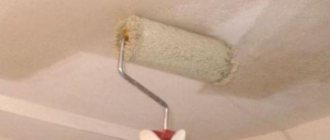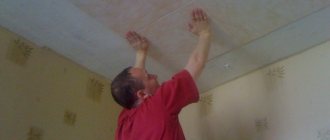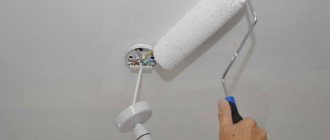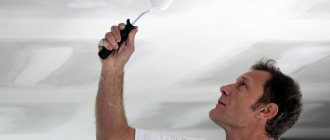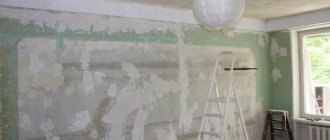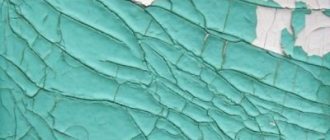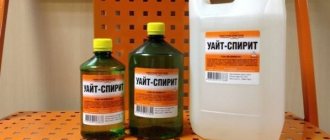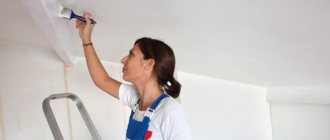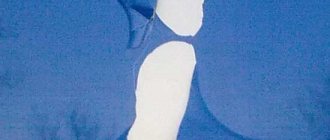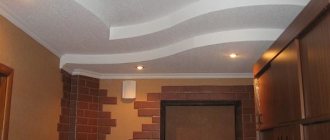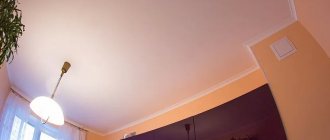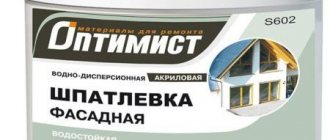Any renovation of a house or apartment, as well as finishing of a newly built home, begins with preparing the required surface for this very renovation. In order for fresh whitewash to adhere well and last longer, it is necessary to carefully remove traces of the old one. If the owner wants to whitewash the ceiling himself, then typical questions arise: how to wash off the whitewash or clean the ceiling or walls of old paint, dirt and dust? Or WHAT to wash off old whitewash or emulsion?
Methods for removing whitewash from the ceiling
Unfortunately, often each new layer of whitewash was applied on top of the previous one, resulting in the formation of an uneven, rather thick chalky or limestone layer on the ceiling. Regardless of the chosen method of clearing the ceiling surface, you should, if possible, clear the room of furniture as much as possible and cover it with plastic film.
Traditional methods of removing whitewash
You can wash off whitewash from the ceiling in the traditional way, if it is based on a chalk or lime composition.
To do this, you can use a regular sponge dipped in warm water. You need to change the water as often as possible, otherwise the chalk dissolved in it will be reapplied with a sponge. Rinsing should continue until the water after squeezing the sponge is no longer cloudy.
Heavily salted hot water is more likely to soften the whitewash layer, so before starting the process you need to add 1 kg of ordinary table salt per 8-10 liters of water to very hot water, otherwise the salt will not dissolve well. The most effective temperature of a water-salt solution for washing off whitewash is 40°C.
It is much more difficult to clean the ceiling from lime-based whitewash. To do this, in addition to a sponge, you will need a spatula. If you remove the layers of whitewash dry, a large amount of harmful dust will form in the room, so the process of clearing the ceiling from lime whitewash should be organized as follows:
- Protect the floor surface with plastic film, old wallpaper or at least newspapers;
- Moisten a small fragment of the ceiling, no more than 1×1.5 m, generously with warm water. To do this, use a roller, spray bottle, or wide hard brush;
- Wait until the lime layer is sufficiently wet. This will be indicated by the darkening of the whitewash layer;
- Remove the whitewash layer that has lost its hardness with a spatula;
- Wash off the remainder with a sponge.
Before performing work, you should protect your hair and eyes, it is advisable to use safety glasses. Minor fragments and dust particles of lime can seriously injure the eyes.
To quickly remove whitewash, professional craftsmen use a solution of hot water with soda ash and laundry soap. The disadvantage of this method is that its traces will also then need to be washed off from the ceiling surface. Residue from soda ash can interact with many adhesive-based paints, and traces of soap due to the fat it contains will prevent an even application of the layer.
But in difficult cases, you can use this recipe.
Composition for washing off lime whitewash:
- 12 liters of water;
- 2 tablespoons of laundry soap, grated;
- 5 tablespoons of technical soda ash.
A ceiling painted with water-based paint can also be cleaned with a spatula and a trowel with an abrasive surface, or regular wooden grout. You can remove old whitewash based on water-based paint faster by adding a medicine bottle of iodine to hot water (10 l).
The most common way to remove whitewash
The most popular method that most people choose to remove the old limestone layer is to remove it with a spatula. This option is very effective if you are working with a thick layer of old lime.
Tools and materials you will need:
- wide metal spatula;
- hot water;
- brush;
- sponge.
How to remove old whitewash from the ceiling:
- Wet part of the ceiling generously with water using a sponge.
- Leave the lime to soak for 10-15 minutes.
- Wet the next section of the ceiling with water.
- Remove the swollen layer from the soaked area with a spatula.
- The part that you wetted with the second one, while you were removing the lime from the previous area, should have already become soaked. Remove the whitewash from it, after wetting the next area.
- Treat the entire surface in this way.
- We recommend cleaning off any remaining traces of lime with a stiff brush.
Wet cleaning
In cases where there is no sanding machine, you can clean the whitewashed ceiling by simply washing it off.
The procedure for how to properly wash off whitewash from the ceiling:
- To wet the ceiling, use warm water and a foam sponge. This procedure can also be carried out using a brush or spray bottle, spraying water from a distance of 60-70 cm to the ceiling.
- To prepare the solution for washing, in addition to warm water, use 3 tablespoons of washing powder and 5 tablespoons of soda. Powder and soda can be replaced by ordinary table salt. To apply the finished solution to the base, use a textile roller. Difficult and hard-to-reach areas are treated with a paint brush.
- It should be borne in mind that the process of absorption of water into whitewash occurs very quickly. To quickly remove chalk from the ceiling, as a rule, soaking the whitewash several times helps: this will give the old finish a chance to spread out well. To avoid excess dirt, place a prepared container under the whitewash to be removed.
- Next, a short pause is made until the whitewash softens and becomes pliable.
- A durable spatula or scraper is used as a tool for cleaning the surface. It is necessary to initially prepare for the fact that this method will not solve the problem of how to quickly wash off the whitewash from the ceiling. In this case, you will have to work hard. Once the old layer has been peeled off, the clean surface is treated with sanding paper. Next, a layer of primer is applied.
- All surface defects discovered during grinding must be eliminated using a repair mixture. The most convenient way to do this is to use gypsum putty or plaster. Every hardware store has a large selection of similar materials.
As you wet the ceiling, it is recommended to soak it in small areas, immediately removing the soaked layer. This will make it possible to achieve the maximum goal of how to quickly wash off chalk from the ceiling. In this case, the wetted whitewash will not have time to dry. If the whitewash layer is small, then the procedure can be carried out by simply washing it out. To do this, you will need a stiff brush or rag. However, in this case, the load on the worker’s muscles increases noticeably, since rubbing the surface with a brush requires considerable effort. The process is characterized by a fairly large amount of water that ends up on clothes and the floor.
Method of cleaning stains using paste
To clean the ceiling from whitewash, they use the old recipe of applying paste to the surface. In this case, the paste is cooked independently at the rate of: 1 tablespoon of flour or potato starch per 1 liter of water.
Preparation of paste:
- take a container of the required size;
- filled with water, put on fire and bring to a boil;
- flour is diluted with water until mushy;
- when the water just boils, the flour solution is poured into the water;
- stir and not allowing it to boil again, turn off the fire under the mixture.
After the composition has cooled, it can be used. You need to apply the paste before removing the whitewash from the ceiling. To do this, the composition is applied to the ceiling. When dry, a crust forms, which can be easily peeled off with a spatula.
For ease of work and more accurate collection of the whitewash layer, a small tray for old whitewash is attached to the spatula.
A more convenient option is to use newspapers. They are glued to the ceilings, smeared with paste, before the ceiling is cleared of whitewash. Gluing is done by leaving small corners along the edges, which will need to be pulled when the paper dries. Together with the newspapers, a layer of white deposits will be removed.
After removing the paper, the ceiling should be wiped with a damp brush or sponge, removing all remaining whitewash.
When and why to remove whitewash
- facing with light polystyrene foam tiles, with installation of skirting boards
- wallpapering, incl. washable (as a variant of one of the old methods)
- painting with water-based paint
- installation of a suspended or suspended ceiling made of plasterboard
All these methods have a lot of advantages over a regular whitewashed ceiling, but if you decide to resort to any of them, with the exception of hanging or tension structures, then you will have to remove the old whitewash from the ceiling.
If this is not done, then it is impossible to guarantee that the new coating will adhere well. Chalk and lime are not intended for painting, wallpaper or tiles. Wallpaper glue leads to a chemical reaction, as a result of which the bleached layer breaks down and foams. This will lead to the fact that both the wallpaper and the tiles will soon begin to fall off.
Please note: only suspended and suspended ceilings are indifferent to the presence or absence of whitewash, but only in one case: when there are no mold spots on the surface, i.e. it is not affected by fungus (the main reason for this is humidity, for example the consequences of flooding)
In this case, it is also necessary to pre-clean the ceiling from whitewash in order to treat it with an antifungal agent.
In addition, in some old apartments (for example, in the “Stalinist” building), the layer of ceiling plaster after many repairs acquires an impressive thickness and can simply collapse under its own weight
In this case, removing whitewash from the ceiling also acquires the status of a vital operation, even if you just want to whitewash it again
Washing off lime whitewash
- Unfortunately, lime whitewash often creates many more problems than chalk whitewash, so many methods associated with the prompt removal of whitewash may fail. In the worst case, the owners will simply lose time, which is worth its weight in gold in the repair process.
- Most often, in this situation, it makes sense to use a soap solution, which demonstrates the greatest effectiveness. However, unlike the method we described earlier, you should use more grated soap to significantly increase the effectiveness of the solution.
- In addition, unlike the previously described method, the solution should not be sprayed over the surface, but rather rubbed with a damp sponge. This, again, will increase the efficiency of using the mixture, and washing off the lime whitewash will be easier. The interesting thing is that there is simply no point in using these recommendations for chalk whitewash.
Technology
Let's consider the stages of traditional washing of whitewash from the ceiling.
- You have water and a spray bottle. Now you need to moisten the ceiling. Try to do this evenly. If you pour a lot of water in the same place, it will eventually start dripping from the ceiling. The whitewash should absorb moisture. Only in this case will the chalk swell. Therefore, take a small area of a couple of square meters and begin to moisten them evenly. If you notice that the water has been absorbed, wait 10 minutes and then moisten the same area again.
- Now you can eliminate the old whitewash. At this stage, a spatula will come in handy, with which you will have to clean off the whitewash. If you have properly moistened the ceiling, the chalk will come off in thin layers. If the whitewash runs down the trowel, you have used too much water.
- To ensure that the work occurs continuously, while one part of the ceiling absorbs water before the second pass, moisten the remaining areas. While you are cleaning the chalk from one place, another will already be completely saturated with water.
- At the end of the work, the ceiling must be washed. Warm water and a foam sponge will help with this. It’s easy to check the quality of work: when the ceiling is dry from water, run your finger over it. If there are no white marks on your finger, then you did everything right. If there is some chalk left on the surface, there is no need to start washing again. It is enough to apply a primer for whitewashed surfaces to the ceiling.
Removing whitewash in the traditional way
After all the preparatory work, you can proceed directly to removing the whitewash.
Step 1. First, thoroughly wet as much of the ceiling as possible. Wetting with water is done using a spray bottle, sponge, brush or roller - you can use any of these items. However, it is worth remembering that moisturizing should be thorough, but not excessive.
Moisturizing the ceiling with a spray gun
Step 2. After a few minutes, the wetting procedure is repeated.
Step 3. The next stage depends on the thickness of the whitewash layer and the type of coating (the latter can be chalk or lime). If not too much chalk is applied, then you can simply wash off the whitewash with a sponge, which is periodically rinsed in a bucket of water, and then simply wipe the coating off the ceiling.
Step 4. If the chalk was applied too thickly or lime whitewash was used, you will have to use a spatula. With its help, the soaked coating is scraped off the concrete.
Removing wet whitewash from the ceiling
At this stage it is convenient to determine how well you have moistened the coating. If water flows from the spatula, then there is too much of it, and you need to wait until it dries a little. If dust appears during work, then the chalk was not moistened enough.
Step 5. Ideally, while work is going on in one area of the ceiling, another part of it should be saturated with moisture. Before you begin scraping away the chalk, wet another piece of the coating.
Step 6. When all the whitewash has been removed from the surface, the ceiling is thoroughly washed with a damp sponge.
Use your hands to check that the ceiling is completely clean. Run them over the dry concrete - if there are white marks on your hands, you will have to wash it again.
Experienced craftsmen advise: it is best to wash off the whitewash not with plain water, but with salted water. The solution is easy to prepare - 1 kg of ordinary salt is stirred in a bucket of boiling water and then the water is cooled to a temperature of about 40 degrees. The composition is ready for use.
Experts recommend moistening the whitewash with salted water.
It is also worth remembering that when wetting the ceiling and washing it, the water should be changed as often as possible - the purer the liquid, the better the work will be.
Useful tips
When starting repair work, you should follow safety precautions and work using protective equipment.
Particular attention should be paid to the fact that lime and other materials can get into the eyes, thereby causing burns or other damage to the cornea. Work only with special safety glasses!
It is important to pay attention to the fact that washing off the whitewash from the ceiling can wet the wiring, so you should turn off the lighting during work. If there is not enough light, the necessary places are illuminated with a flashlight or a carrier
If you don’t have a special remover at hand or it is impossible to use any of the methods described above, you can use a homemade mixture.
For a homemade wash you need:
- fill a bucket with 5 liters of water;
- add 5-6 caps of bath foam and 1 tbsp to the water. a spoonful of vinegar;
- Small areas of the surface are treated with this soap-vinegar mixture;
- you should wait 5 minutes until the surface becomes limp;
- using a spatula, clean the ceiling;
- when the work is finished, the ceiling is washed with warm water.
When working with a homemade remover, be sure to lay old newspapers or any oilcloth on the floor, as there will be plenty of dirt.
You can use another method that does not require a special investment of money - using ordinary salt. Table salt is added to warm water. For 10 liters of water you should take a 1 kg pack of salt. Such a homemade wash will cost very little, and the result will be no worse than when using other means. It will be possible to easily and without extra effort clean the whitewash from the ceiling.
Mixtures prepared with your own hands will be much more economical than purchased options. One of the old methods used to remove traces of whitewash from the ceiling is to use a solution with laundry soap. For the solution, use laundry soap that does not contain dyes or other additives. In this case, it will be better at removing white from the ceiling and walls. Add a spoonful of baking soda and 2 or 3 tablespoons of laundry soap shavings to a small bucket (5 liters) of warm water.
After renovation work, it is difficult to get rid of traces of whitewash on the floor. Even if you put oilcloth, plastic film or newspapers on the floor, there is a high probability that the floor will still become dirty. You can wash off whitewash from the floor by wiping it with water and vinegar; if it is very dirty, you should wash the floor at least three times.
By using any of the above methods you can get rid of whitewash on the ceiling. Each of them has its own advantages and disadvantages. Which one to use is up to each person to decide individually; it may depend both on the funds available and on some other conditions.
To learn how to wash whitewash from the ceiling, watch the video below.
Useful tips on how to clean whitewash from a ceiling
Regardless of which of the above methods for removing whitewash you decide to use, keep a few more points in mind.
- If the area to be removed is large, treat it in small sections. For example, while the product is absorbed into one area, you are treating another. This will help you save a lot of time.
- When choosing a spatula, look for a special spatula with a container. When working with it, all dust and dirt will be collected in a container without scattering around.
- If any part of the whitewash does not want to come off, use a hammer to knock it out.
How to clean it yourself: review of products
Flush with water
If the whitewash layer is relatively thin, it can be washed off with water.
- Dissolve 1 kg of salt in 10 liters of hot water.
- Allow the solution to cool to 45 degrees.
- Soak a sponge in the solution and wipe the ceiling until the chalk is completely washed off from the base. You should work carefully so that the drops do not start flowing down your hand or dripping onto the floor, head or clothes.
- The ceiling is washed off with a sponge, removing layer by layer until a clean surface appears. Change the water as often as possible, and rinse the sponge in clean running water.
How to remove using paper?
Stages of work:
- Prepare an adhesive solution for wallpaper (you can use paste).
- Using a wide roller, the solution is evenly applied to the ceiling surface in a thick layer.
- Old wallpaper, newspapers or paper are soaked in an adhesive solution, then pasted onto the prepared surface until dry.
- When the wallpaper or newspapers are dry, they are removed from the ceiling. Along with the paper, the old whitewash is also removed. If the coating still remains in some areas, it is scraped off with a spatula.
Attention: For ease of work, the edges of wallpaper or newspapers are left unattached to make them easier to remove.
Removal with paste and wallpaper glue without dust and dirt
Stages of removing whitewash with wallpaper glue or paste:
- Prepare wallpaper glue or paste. To prepare the latter you will need flour or starch and water. Flour or starch is dissolved in 1 liter of warm water, slowly poured into boiling water, stirring until completely dissolved (the volume of boiling water is approximately 3 liters).
- Cover the ceiling thickly with glue or paste, let it dry a little (not until completely dry), but the coating layer should be thick.
- Remove the wet whitewash layer with a spatula.
Quickly using a sander
Removing old coating with a sander is a simple, quick way. When working with a sander, you should take care of safety equipment
Special solutions
- Concentrated detergent for cleaning after renovation work ALFA-20 copes well with lime and chalk whitewash. To work, the product is diluted with water in a ratio of 1/20 and applied to the surface with a brush, roller or spray. The solution is left for a few minutes and then the coating is removed with a spatula.
- Metylan wallpaper remover is diluted with water in a ratio of 1/10. It copes well with lime and chalk compounds, its operating principle is the same.
- A special composition for removing whitewash - Probel - is dissolved in water and then washed off with a sponge. The remaining coating is removed with a spatula.
- Cleaning concentrate from Probel is also suitable for washing off old coating. The composition is diluted with water in a ratio of 1/20 and applied to the surface. The ceiling is cleaned with a spatula.
- To do this, dissolve 2 tablespoons of ammonia in 3 liters of water, add a soda solution, 2 caps of bath foam, and 1 tablespoon of vinegar.
- To prepare a soda solution, dilute 1 part soda in 3 parts water.
- Pour 2 liters of boiling water into the finished composition and cool to a temperature of 50 degrees.
- Apply to the surface and then remove the coating with a spatula.
Safe products and tools
When removing whitewash, use personal protective equipment.
Before washing off the chalk from the ceiling, you need to prepare special tools and devices. They make work easier and more efficient. You need to get:
- plastic film and newspapers to protect the floor and furniture;
- a respirator, prevents dust from entering the lungs;
- construction glasses to prevent debris and dirt from getting into your eyes;
- a special cap or scarf to protect your hair from contamination;
- a sprayer for moistening whitewash, a model for irrigating flowers is suitable;
- comfortable clothes and shoes; the ideal option would be sweatpants and an old T-shirt that you don’t mind getting dirty;
- rubber gloves will protect the delicate skin of your hands from negative effects;
- a small spatula or scraper with a pointed tip;
- a soft foam sponge or an unnecessary washcloth, clean rags, cold and hot water.
To reach the ceiling, you will need a stepladder; it is much more convenient to work with. If you don’t have a stepladder, you can replace it with a durable table. An old tablecloth is placed on top, then a film is applied.
Safe chemicals
Quelyd Dissoucol remover will help remove whitewash and wallpaper.
Special removers will help you remove whitewash from the ceiling most quickly and effectively. The compositions are applied to the whitewash, left for some time, then the coating is removed with a scraper. The materials are completely cleaned off, no rinsing is required. Chemicals can be purchased at building supply stores.
Metylan and Quelyd Dissoucol
Effective compositions that help quickly remove a layer of whitewash, as well as wallpaper. Active components penetrate into the deep layers of coatings, breaking them down.
Metylan and Quelyd Dissoucol are highly concentrated liquid products produced on the basis of surfactants. Sold in 0.25 liter bottles. This amount is enough to dilute in 15 liters of water. After use, the chalk can be easily removed without leaving streaks.
Probel
Suitable for removing dust, plaster and chalk coatings. This is a professional concentrated product with neutral pH. It looks like a clear liquid, is odorless and colorless, and foams a little. The drug is diluted with water in a ratio of 1:100. To wash away the whitewash, the resulting mixture is applied to the coating, then washed off with warm water after the material has dissolved. Subsequently, no traces remain on the surface.
Alfa-20
Removes lime and chalk and is used for cleaning premises after renovation. The drug is a concentrated composition with a greenish tint and apple aroma.
Alfa-20 is produced on the basis of acid, therefore it effectively washes away even the most severe, old stains. To remove lime, the concentrate is diluted with water in proportions of 1:15. The product completely removes whitewash, old rust stains, and streaks left after flooding.
The listed preparations quickly and effectively wash off the whitewash. They are easy to use and do not cause any inconvenience. One package of chemical is enough to treat a large area of the ceiling.
When working with concentrated drugs, it is important to follow safety standards. Hands are protected with rubber gloves, eyes with goggles.
Folk remedies
You can wash off the whitewash from the walls using a regular sponge and water.
Using folk recipes for blurring the whitewash also gives a positive result. Their use will not require extra financial costs, and all components are natural and environmentally friendly.
Washing off with water
This method is the most common and simple. The coating is washed off with warm water. To do this, you will need a cotton cloth or a foam sponge, a bucket of clean water, and a stepladder.
The rag is soaked in water, then it removes dirt, dust, and whitewash. The method only removes chalk.
Soda and soap solution
To dissolve the white faster, you can use not just water, but a special solution. Laundry soap is grated. 2 tbsp. l. shavings and 5 tbsp. l. soda ash dissolve in 10 liters of water. The components are thoroughly mixed.
To quickly wash away the whitewash on the ceiling, you will need to put on protective gloves on your hands, then soak a sponge or piece of cloth in the resulting solution. Next, the whitewash is gradually washed off. In order for the composition to retain its properties longer, it is better to pour the liquid into two containers.
Paste
Paste will help you get rid of whitewash without damaging things in the room. You can prepare it yourself. You will need 1 tbsp. l. flour per liter of water. First, the flour is diluted in a small amount of warm water. The resulting composition is slowly poured into boiling water.
After the mass has cooled, the paste is ready for use. It is distributed over the ceiling using a roller. After 10 minutes, the product will dry and can be removed with a scraper along with the white. When the procedure is performed correctly, the coating is removed in layers and does not generate dust.
For ease of use, a small plastic tray is attached to the spatula. Then the separated material falls into it, and not onto the floor.
Paper
Newspaper sheets will help remove whitewash. They must be glued to the ceiling using wallpaper glue or paste. One corner of the paper is not glued so that it is easy to grab and pull.
After complete drying, the newspaper is torn off from the ceiling, and the coating layer is removed along with it. After this, the canvas is washed with a wet cloth. Contamination will have to be additionally cleaned with a spatula.
Homemade washes
There are products whose effect is similar to store-bought concentrates, but you can prepare them yourself. Here are some recipes:
- A couple of caps of bath foam and 1 tbsp are dissolved in 5 liters of water. l. vinegar.
- A solution of kitchen salt (10%) is suitable for removing chalk. A bucket of water will require 1 kg of salt. The composition is used warm.
Homemade washes are applied according to a standard pattern. You will need a rag or a foam sponge and a stepladder. It is recommended to protect your hands with gloves.
Sander
The use of equipment allows you to quickly get rid of old coating. The main disadvantage of this procedure is the huge amount of dust and debris. This method is only suitable for major repairs.
In hardware stores you can find sanders designed for cleaning surfaces. These tools are equipped with a vacuum cleaner that instantly absorbs dust. This way you can get the job done not only quickly, but also without getting dirty.
The cost of such equipment is quite high, so it is better not to spend money on a device that will be used once. An alternative to a grinder is a drill or grinder with a metal brush.
Among the listed methods, everyone will find a suitable option for themselves. You can wash the whitewash from chalk with plain water; the lime must be removed with a scraper after moistening. Using a chemical or household cleaner will get rid of dust. The cleaned surface can be whitewashed, painted, decorated with wallpaper and other finishing materials.
Preparatory work: tools and materials
Before washing off the whitewash from the ceiling, you need to prepare:
- wide sheets of polyethylene film;
- an ordinary medical mask or respirator;
- special glasses for eye protection;
- headdress (scarf, comfortable cap);
- water spray or vacuum cleaner;
- spatulas of different widths;
- comfortable clothing that does not restrict movement, preferably with long sleeves;
- rubberized household gloves;
- the right amount of hot or warm water;
- stable scaffolding (you can take a table);
- large household sponges, gauze (for washing the ceiling).
Before removing whitewash from the ceiling in a room, it is advisable to remove all furniture from it. The work of cleaning the ceiling from whitewash involves a lot of dirt and dust, so if it is impossible to remove all large interior items, they must be covered with film as thoroughly as possible. It is possible to lay cardboard or large sheets of newspaper on top, and securely secure the film with adhesive tape.
Otherwise, in addition to cleaning the room, you will have to clean all furniture surfaces. Therefore, before removing the whitewash from the ceiling, you need to think through and solve this problem in advance.
Useful information: “How to whitewash a ceiling using old whitewash”
The floor in the room is covered with film and paper. It is necessary to keep a damp cloth at the entrance to the room to wipe the shoes when the master leaves the room, otherwise all the dirt will spread throughout the apartment.
Preparing for work
Before you start removing old whitewash, you need to prepare your workspace. To do this, if possible, remove all the furniture from the room. If this is not possible, then it can be covered with a special construction polyethylene film. The film will protect your furniture from dust and dirt that may arise during work.
To prevent dust and other things from getting on you, you also need protection. Of course, it is best to do such “dirty” work in special clothing. But if you are doing repairs yourself at home, you can use improvised means. Wear gloves (you can use latex ones for the kitchen or buy non-sterile medical gloves at the pharmacy). Cover your head with a headscarf, cap or baseball cap. The eyes will be protected by glasses, and the respiratory organs will be protected by a respirator (perfectly replaced with a medical mask from the pharmacy). Well, and of course, use old clothes and shoes (slippers, T-shirts, tights), which you won’t mind throwing away later.
Be sure to use a stable stepladder or sawhorse. This is much safer than building a ladder of tables and chairs on it. After all, the average ceiling height in our houses and apartments is at least 2.5 meters, and not every person can boast of such height as to reach the ceiling without a stepladder.
How to remove whitewash from a rusty ceiling?
Despite the strength and reliability that a whitewashed ceiling has, it is very difficult to prevent the appearance of rust stains. Rust stains on a white surface look untidy.
Whitewashing such a ceiling again from above is useless, since rust will appear through new layers. It is best to remove such whitewash using a solution of vitriol.
To prepare such a solution, you will need water (10 l), soap (250 g), dry glue (240 g), chalk (2.5 kg), drying oil (30 g), copper sulfate (130 g).
First you need to dissolve the vitriol in water, then add everything else there and mix thoroughly until a homogeneous mixture is formed.
The finished product must be applied to the ceiling (so that it gets into every corner). After a little time, until the whitewash has dispersed, try to clean the surface with some kind of tool (a spatula is ideal).
If the entire layer has come off well, wash the entire ceiling and start sanding.
Ways to remove whitewash as quickly as possible
With proper organization of the work process, you can wash off the oldest whitewash in a couple of hours of hard work. You can work alone, but if the work needs to be done efficiently and, most importantly, quickly, you will have to look for an assistant.
To work, you will need to make two tools on a long wooden handle:
- The first tool is a board to which several shoe brushes with short, stiff bristles are nailed;
- The second device is assembled from several foam sponges attached to a long plastic handle.
To quickly wash off whitewash, it is better to use a hot soapy solution. You will have to work with the tools one at a time, which is why you need at least one assistant.
Initially, rub a small area of the ceiling with a block of brushes with hot soapy or soda water, preferably in the form of a strip 25-30 cm wide, along the entire length of the room. After 2-3 minutes, the swollen chalk is washed off with a block of sponges on the handle. Part of the solution gets onto the laid floor, so the liquid must be quickly wiped off with a cloth so as not to damage the floor covering and shoes.
The quality of the flush depends on experience and ability to work with a brush block. To remove chalk dust embedded in microcracks and pores of concrete, you have to quickly rub the soap solution on the ceiling with brushes until foam appears.
After you have managed to wash off the top and most durable layer of chalk on the ceiling, small traces of whitewash always remain on the surface. While the concrete is still wet, they are practically invisible, so after 30-40 minutes the ceiling will need to be wiped with a sponge again, this time with clean water. To determine whether chalk remains on the concrete, you don’t have to wait for the ceiling to dry; just run your finger over the wet surface to see traces of chalk. If the chalk had to be washed off with an alkaline solution of caustic soda, then the second pass will need to be done with the addition of a small amount of vinegar.
Preparation of tools and premises
Depending on the choice of method for removing the topcoat, you will need the following set of tools and materials:
- Grinding machine for plaster and concrete, or construction float;
- Spatula and hammer;
- Container for water;
- Roller or spray bottle;
- Ladder;
- Sponges and rags;
- Protective equipment.
Aspro grinder
For a detailed review of how to choose whitewash for the ceiling, read a separate article.
You won’t be able to quickly wash off the whitewash if you don’t prepare the room appropriately. All interfering interior items are removed from it, especially sofas and armchairs, the upholstery of which can be hopelessly damaged by dirty water, pieces of lime and chalk dust.
Heavy, large-sized furniture that is difficult to move is thoroughly covered with waterproof film and secured with tape. The floors are covered with newspapers and wrapping paper. Chandeliers and other lighting fixtures are removed from the ceiling surface, and the wiring is de-energized to prevent a short circuit. The following supplies are required:
- stepladder and a container of hot water;
- soft sponge, rags and high-quality waterproof film;
- a two-liter plastic bottle with holes in the lid to quickly moisten the surface;
- safety glasses and respirator;
- hat, rubber gloves and work clothes.
Careful preparation of the room will allow you to clean the ceiling quickly and efficiently
You should place a wet cloth on the threshold. It will help wipe off dirty shoes when moving from the room where work is being done to a clean room.
Preparatory stage
To remove whitewash from the ceiling successfully, you need to be thoroughly prepared, since the work itself is difficult and dusty.
It is necessary to create all the conditions for work in advance.
An additional complication is that the workplace is located above your head, which is not entirely convenient.
Here's what you need to do before removing whitewash from the ceiling:
- 1. Remove all things and objects from the room in which you are planning to renovate.
- 2. If there are any things or furniture that cannot be removed, cover them tightly with plastic wrap.
- 3. Cover the floor with film or canvas, and spread paper or newspaper on top so that unnecessary moisture is well absorbed.
- 4. Prepare appropriate protection for yourself: cover your hair, put on things that you don’t mind getting dirty, as well as glasses and a respirator.
- 5. Depending on the chosen method of cleaning the ceiling, stock up on the necessary tools and don’t forget about the stepladder.
Method for removing whitewash from the ceiling step by step
Work in small areas: this will make it easier to cover the entire surface.
Before washing off a layer of old or new whitewash from the ceiling, it is necessary to carry out preparation. Following the rules guarantees a good result:
- Everything unnecessary is removed from the room so that moving with a stepladder does not cause difficulties. The floor surface is covered with polyethylene and covered with newspapers on top. A damp cloth is placed at the door for wiping shoes. Then construction dust will not get into neighboring rooms.
- Before starting work, wear suitable clothing, gloves, a hat, safety glasses and a respirator.
- You need to bring a bucket of clean cold water and a container of boiling water into the room to quickly prepare a sufficient amount of warm liquid.
- It is better to use a spray bottle to apply water. Cold liquid is poured into it, then boiling water. It’s better to take a small bottle so that your hands don’t get tired quickly and you still have the strength to scrape off the white.
- The entire surface of the ceiling should be sprayed with water. Spraying is carried out evenly. If you over-wet the whitewash, liquid will drip onto the floor.
- After some time, the procedure is repeated. After 10 minutes, you can begin to directly remove the white.
- It is better to remove the top layer with a spatula. During normal soaking with water, the coating will separate in small layers.
If there is not enough liquid, the chalk becomes dusty. In this case, you will have to repeat the moisturizing. If the lime spreads on the scraper, there is too much water, then it will take additional time to absorb. The cracks are widened with a scraper while they are moistened. This will help significantly speed up the workflow. After cleaning with a spatula, the ceiling is washed with warm water using a sponge.
After cleaning and the ceiling has completely dried, you need to run your palm over the surface. If no traces remain on it, this is an indicator of the quality of the procedures. Now you can use any finishing materials.
Why wash off the whitewash from the walls?
If you plan to renovate in accordance with the latest fashion trends and using the latest materials, then most likely you will not have to remove the whitewash (for example, when installing a stretch ceiling). But there are other cases that require careful rough work.
You cannot do without washing off the old whitewash in the following cases:
- before painting or gluing wallpaper, since the lime layer reduces the quality of adhesion of these materials to the surface;
- before new whitewashing using a composition different from the old one (adhesion to the previously applied solution may be short-lived);
- before installing a heat or sound insulating coating;
- before sealing joints (using putty, plaster) or eliminating cracks;
- when rust, mold or soot stains occur that are difficult to cover up and it is better to remove them completely to prevent their appearance in the future.
In other, unmentioned cases, it will be enough to simply remove the exfoliated whitewash with a sanding machine and remove the dust with a brush.
Traditional whitewash removal
- Despite the fact that the above recommendations often work for removing whitewash of various thicknesses and compositions, it also happens that the manufacturer adds special components to the material, making it almost impossible to easily get rid of the white layer. Therefore, it is worth considering the traditional methodology of this process, which, by and large, also does not take very much time.
- First of all, the ceiling is moistened using a roller soaked in water or a spray. The main rule in this matter is to use a small amount of water, since later it can simply drain from the ceiling, which creates many problems.
- If the surface is moistened, after which the water is simply absorbed into the whitewash, you should use a little more water. Humidification occurs within a small area. You should concentrate on 2-3 square meters, no more.
- If the dampening of the ceiling went well, then using a spatula the whitewash will be removed without problems, and there shouldn’t be any particular difficulties with the walls. It also happens that water flows through the spatula while removing whitewash. This happens because too much water was used at the beginning of the process. You should wait a little for the situation to become more stable.
- The process should be carried out continuously, removing one area of whitewash while simultaneously moistening another.
- Ultimately, you need to clean the ceiling with a damp sponge. Unfortunately, this is quite a dirty job, so you should get a special suit and glasses, which will definitely simplify the process when removing whitewash on the ceiling. If, after washing off, whitewash still remains on the ceiling, the process is carried out again, and so on until traces of the material disappear.
__________________________________________________
What is whitewashing?
This is a ceiling covering using lime or chalk mortar, which creates pores.
Through them the surface is able to breathe. This ceiling finish is durable and resistant to abrasion. Whitewashing remains one of the popular ways to decorate a home, but many are already asking the question - how to clean the whitewash from the ceiling?
Regardless of what material you are going to use to decorate the new ceiling and wall coverings in the room, the previous whitewash must be removed.
Stages of washing off paint
Despite the scale of the work, whitewash can be removed quite quickly by following the stages of the work. Repairing, in principle, does not involve a fun pastime, but strictly following the instructions will make the process more comfortable and clean.
Preparation
Preparing the room
The first stage of work involves preparing the room for ceiling repairs. This step is necessary in any case to protect walls, windows and furniture. After the preparatory work, all that remains is to decide how to wash away the old whitewash from the ceiling and begin work.
What to do before removing the chalk layer:
- cover windows, frames, window sills with transparent film;
- remove or cover furniture with film, blankets, rags;
- remove mirrors, remove small interior items (lamps, paintings, chandeliers, books, photos);
- cover the floor with film or newspapers;
- seal the sockets with masking tape or polyethylene;
- cover the walls (bare walls with peeled wallpaper can be left like this);
- turn off the electricity in the room and take care of the light source (bring a flashlight, connect an extension cord from another room, use diode lamps);
- place a wet rag in front of the entrance door to wipe your feet before leaving and close the gap between the door and the floor;
- prepare a stable stepladder with which it is convenient to reach the ceiling;
- prepare ammunition - plastic glasses, a scarf, a respirator or gauze bandage, comfortable work clothes.
To prevent sheets of film from moving apart on furniture and the floor, it is recommended to secure the joints with tape. Furniture can be previously covered with special thick covers. It is better that the protection hides the interior completely, right down to the floor, since dust easily penetrates into any cracks and holes.
Covers will protect furniture from dust
Tools
Required Tools
The choice of how to wash away the whitewash on the ceiling depends on the type of finish and the abundance of stains. The limescale layer or paint can only be removed using a scraper - in a dry way. For deep stains and mold, you will need additional tools and liquids - soap solution, antiseptic, acids, solvents. Methods for combating mold and rust should be studied separately.
| Image | What is it needed for? |
| It is easy to remove layers of whitewash with a scraper |
| Warm water is poured into the container to wet the surface. |
| Needed to moisturize whitewashed surfaces |
| Removes dirt and chalky layers |
| Necessary for atomizing moisture |
| Easily applies soap solution and moisture to large areas |
| Convenient for collecting pieces of whitewash when working with a spatula |
| Useful for washing cleaned surfaces |
The chalky layer is washed off with plain warm water, but in some cases you will need a prepared solution for rinsing. In case of difficult whitewash removal, it is recommended to prepare in advance:
- laundry soap;
- soda;
- flour;
- bubble bath;
- vinegar;
- whiteness;
- iodine;
- salt.
The price of all tools and means is low. Everything you need to process the ceiling can be found in a hardware store, hardware store or at home.
Flushing process
When a preliminary analysis of the work has been carried out, all the necessary tools and methods of protection have been prepared, cleaning should begin. This can be done in two effective ways - wet and dry.
| Method | Instructions |
| Wet the surface and wait for it to dry. Clean off the whitewash with a spatula. If necessary, wet and clean again. Remove any remaining chalk with a damp sponge. |
| By “tapping” the hollow layers of whitewash with the back of a spatula and carefully removing pieces of paint with a blade, you need to clean the surface of the ceiling. For convenience, you can replace the wide blade with a narrow one. Upon completion of the procedure, wash the dusty surface with a damp cloth or sponge. |
Completion
After you have more or less succeeded in washing off the whitewash on the ceiling, you need to evaluate the work, work on particularly difficult areas and wash the surface with plain water. Sweep up the settled dust and pieces of whitewash, collect in one place and throw away. When the surface has dried, you can begin repairs - new whitewashing, wallpapering or insulating boards, painting.
Ceiling cleared of whitewash
How to whitewash a ceiling correctly
The most correct way to whiten a ceiling surface is to use a fairly liquid solution that penetrates well into microcracks and pores
This method remains more labor-intensive and requires care and attention, since missed areas on the ceiling will instantly be highlighted after drying
Chalk or lime is applied in at least two layers
How to dilute whitewash for the ceiling
There are two ways to whitewash a ceiling slab, either well or quickly. Usually they recommend at least 2 kg of slaked lime per 5 liters of water. The result is a very thick paste-like mixture, to which 30 g of laundry soap and the same amount of stationery silicate glue are added. The mass is ground to the state of liquid kefir. In order to whiten with such a mixture, serious physical effort is required, but the result is worth it.
The whitewashing process is as follows:
- The ceiling is generously moistened and soaked with water;
- The liquid lime mass is applied to the ceiling and stretched with a spatula and a stiff brush;
- After 10-15 minutes, the laid mass should be whitened with a lime mortar diluted in half.
Important! The lime “applies” well to the ceiling, but stains remain, so it is important to whitewash it a second time with a liquid composition.
The result is a very uniform, blemish-free, smooth and dense surface. Next time it will be possible to whiten it in 2-3 years.
Mixing should be done 3-4 hours before the start of work
How to whitewash a ceiling with the first layer
If you use a standard mixture of 1.7 kg of lime per 10 liters of water, you will have to whitewash it at least two, or even three times, depending on the quality of the concrete ceiling. Before whitewashing, you need to moisten the ceiling sparingly; there is already a lot of water in the solution itself, and its excess has a detrimental effect on the quality of the work.
The first layer is applied with a roller or brush. Despite the liquid solution, lime also needs to be rubbed into the ceiling, otherwise the first layer will not stick to the concrete. Whitewashing with a pneumatic sprayer or a knitting brush will not work; all the lime will end up on the floor of the room.
I rub lime on old whitewash with a spatula
Special solutions
To make removing the old layer more convenient, special flushing compounds are sold in building materials stores. They are simply applied to the surface of the ceiling, and after drying they are removed with a spatula. In this case, the process will occur without excess dust, since the whitewash layer can be easily removed. There is an easier option for preparing a rinsing composition than buying it in a store.
To do this, take a bucket of water and dilute two tablespoons of ordinary table vinegar and 2-3 tablespoons of dishwashing liquid in it. After which the warm solution is applied to the ceiling. Removing old whitewash indoors is not as difficult as it seems at first glance. With certain skills and the necessary materials and tools, a novice master can handle this work.
